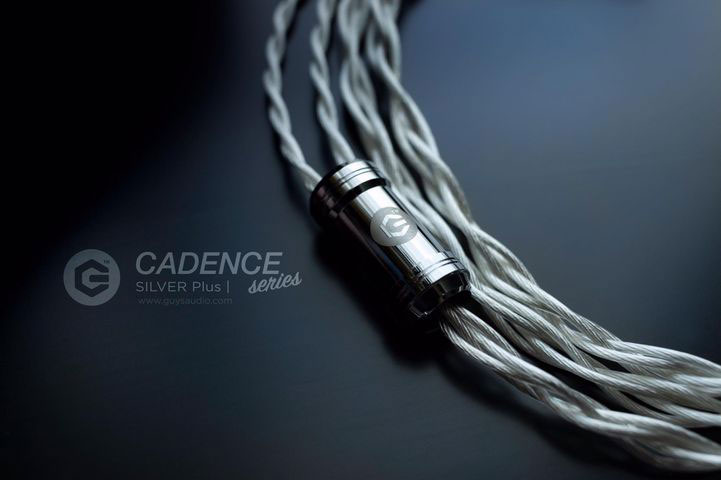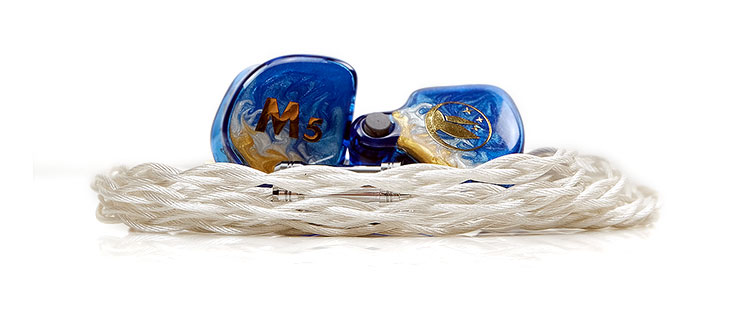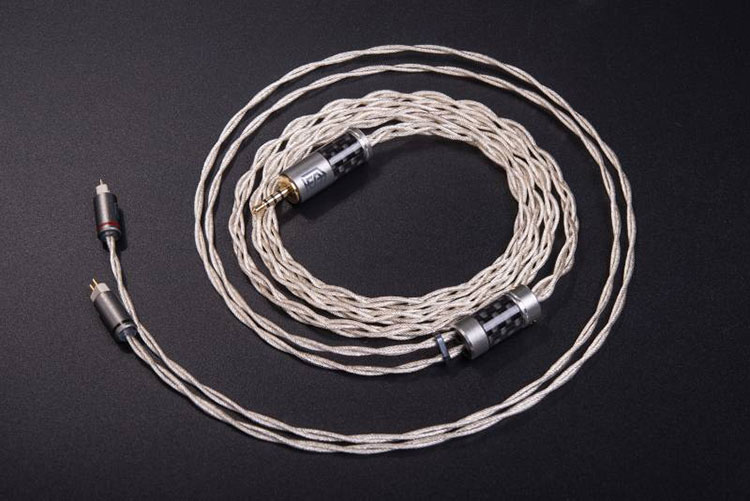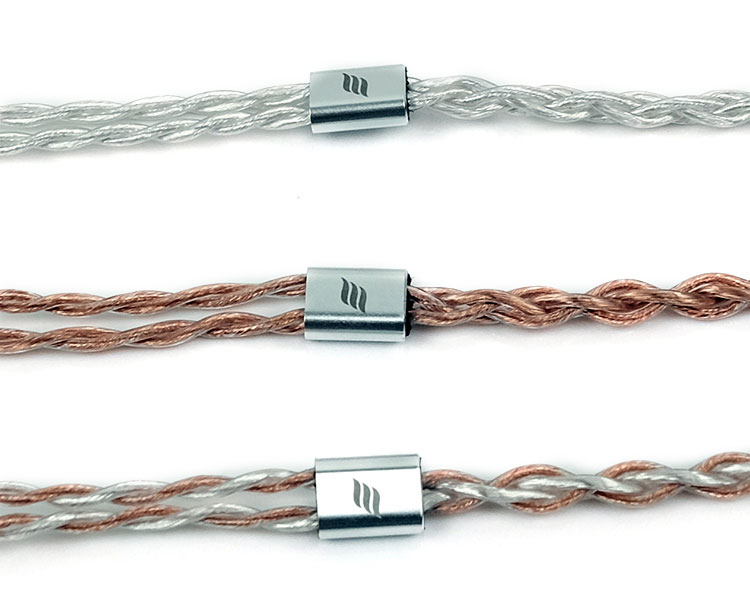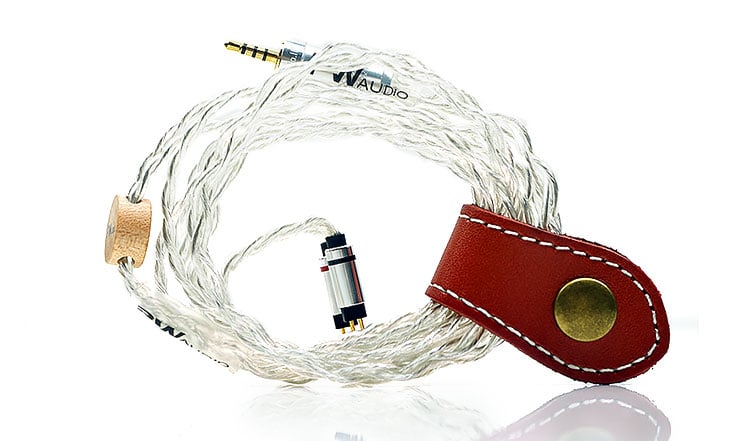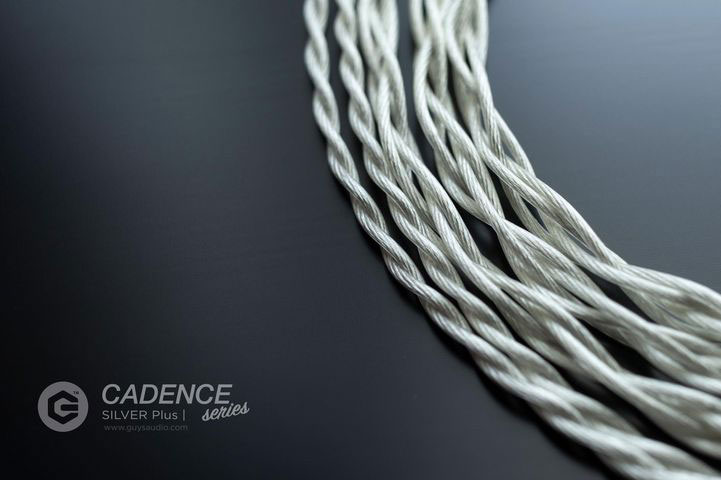Performance Impressions
(Testing was completed using a Vision Ears EVE20, 64 Audio tia Trio, MMR Gae Bolg, and Noble Audio’s flagship Sultan).
Summary
The decision to use a 22AWG gauge wire for the Silver Plus was a smart move from GramsAudio. Alongside the PW Audio No 10, it is one of the few cables with this size of wire gauge. The lift in dynamic range from all our tested monitors over the stock or competing smaller-gauge cables is palatable.
That means the transition from relative calm to impactful events is perceptibly more vivid allowing you to pick up a lot more nuanced resolution and articulation in the performance of both monitor and source.
For example, that classic stock P1 4-wire OFC with a lot of high-end monitors such as the VE EVE20 is transformed from soft and polite to firm, precise, and certainly more robust in its delivery with the Silver Plus. Vocals that were sweet and mellow become more ‘nailed on’, precise in imaging, and with plenty of open space from the improved separation.
Even when competing against similar priced 26AWG cables, (see comparisons below), that lift in dynamic range, mid-bass punch, and vocal presence is still distinguishable.
However, I do have to note that although the Silver Plus is a more dynamic performer, it does not tease out huge volumes of bass or warmth. It sounds a little more linear on the low-end than some competing SPC cables.
For example, even though the dynamic range of the Silver Plus was superior to Effect Audio’s Vogue Series 26AWG Grandioso, I did get a feeling of more bass warmth and volume when pairing the Grandioso with the 64 Audio Tia Trio, (dynamic driver). Instead, the Silver Plus pushed down on the excess warmth, improved the layering and definition, producing a punchier performance.
Timbre
I honestly do not find the Silver Plus to overly color the timbre of the monitors tested. Compared to some other SPC or copper/silver mixed cables the timbre of monitors such as the 64 Audio tia Trio had an accurate harmonic balance with the Silver Plus.
This cable is not as warm as the No 10 from PW Audio or as bright and clean as the pure silver of the Satin Audio Medusa II. Instead, it sounded clear, with just a very slight bias to even harmonics over brighter odd-harmonic influences. Just enough to sound very natural and life-like in both instrumental and vocal timbre.
Vocal timbre, in particular, stood out. For some reason, the Silver Plus monitor pairings excelled at pushing out the presence of vocals combined with a solid note weight and a broad texture with our tested monitors.
You could argue though that there is a hint of sweetness in the vocal timbre since I found it less likely to emphasize natural vocal sibilance. Perhaps also due to the way treble was coming through as clean and clear but not bright or lean so it never felt like the Silver Plus was thinning out the tone unnaturally.
Staging
The Silver Plus excels in staging performance. That large 22AWG’s excellent dynamic range creates a very engaging presentation from our tested monitors, particularly dynamic driver hybrids which sound tight, beautifully extended down low, and properly layered.
I mentioned at the top of the page of going from a stock 4-wire OFC and some 26AWG cables’ softer performance to a more precise and defined delivery. In terms of staging, that means clarity, space, and air where a monitor will allow it. Not just air up top, but also openness on the low-end.
For example, the Noble Audio Sultan bass response is excellent but with its own pure copper 8-wire, it can also sound a little on the warm bloomy side. The Silver Plus seems to just clean out a little of that warmth and in doing so opens up the low-end allowing you to hear a more complex bass presentation.
The other big change up is the vividness of the vocal presence region on the Silver Plus pairings. On monitors such as the tia Trio and the Gae Bolg, they had a touch more presence and a lot more note physicality.
On stock cables, the vocals were less distinct and further back in terms of staging. With better quality 26AWG aftermarket cables they had a better level of definition over stock cables but still lacked the same space and clarity of the Silver Plus performance.
Synergy
Dynamic Lift
After testing several monitors with the Silver Plus I came to the conclusion that it synergizes best with monitors that either need a little lift in terms of dynamics or impact or lack a little physicality or solidity through the mids with the stock cable.
For example, the Vision Ears EVE20 uses a fairly standard 4-wire OFC lightweight stock cable which tends to give it a relatively sweet but inoffensive sound signature. Switching to the Silver Plus you get an instant vividness to the sound signature, better separation, and also a bit more weight to instrumental and vocal notes.
Timbre is still relatively natural and to the sweet side but with a bit more resolution on the top-end which I personally like. On the low-end, the better dynamic range of the Silver Plus gives it a better sense of impact and urgency. Overall, it is a huge upgrade on the stock cable.
Vocal Clarity
I also preferred the Silver Plus for vocal clarity over some competing 26AWG cables. Again, it’s a mix of the solidity of the vocal notes combined with the superior dynamic range. Not only was the vocal presence on some of our monitors improved but the space and separation around them were also perceptibly enhanced.
An example of this was the Medusa II from Satin Audio which is a linear neutral cable with a clean sound signature. With monitors such as the Noble Audio Sultan, I found the clarity to be excellent but the note underlying weight or PRaT to be on the lighter side.
Switching to the Silver Plus the low-end impact was instantly improved resulting in a stronger level of PRaT but also a more resolving vocal performance. Compared to the stock Noble Audio 8-wire OCC copper cable, there was also slightly better separation and imaging as well as a bit more top-end presence and air though slightly less warmth on the low-end.
Bass Energy
The final synergy note was the low-end and general clarity. Monitors that benefited from that included the MMR’s Gae Bolg which I find a little bloomy with its stock cable. Switching to the Silver Plus it just evened out the low-end, sounding punchier but also better defined, less bloom, and improved layering.
The Silver Plus does not add weight to the bass performance of monitors, what it does instead is clean it up, define it better, and add a bit more perceived energy.
Select Comparisons
For consistency purposes, we used the 64 Audio tia Trio combined with the Lotoo PAW Gold Touch DAP as our test rig for all comparisons.
Satin Audio Medusa II
$259
We have already done a full review and award the original Medusa our Bang For Buck Cable Award back in 2019. At the time, the price of the Medusa was $209, however recently they launched a new version called the Medusa II and it is now priced at $259. We do have it here but have yet to release a full review. That will come in due course.
Technical
The Medusa II uses SP-OCC Pure Silver Type 4 Litz geometry which some might consider a higher grade of material than SPC, (tonal preferences aside) as well as potentially a more complex Litz configuration.
We do know that the Medusa II geometry does include Kevlar damping combined with its Pure Silver stranding whereas the Litz strands inside the Silver Plus are lacquer coated.
However, the Medusa II wire is a smaller 26AWG gauge rating compared to the 22AWG SPC inside the Silver Plus and its purity level is just a shade behind at 6-7N. I say just a shade behind because sometimes batches are not quite a 7N grade but higher than 6N’s baseline.
Design
The original Medusa was an extremely shiny silvery design, however, Medusa II has toned it down a bit in terms of aesthetics. Compared to the Silver Plus, this is more of an off-white wire finish perhaps colored by Satin Audio’s SA Insulation II jacket materials.
Of course, the 26AWG wire inside means it’s a much thinner diameter and a tighter braiding compared to the bigger OD of the Silver Plus. Simple physics at play here. The thinner wire means Satin Audio can braid at much shorter intervals and in a more intricate pattern compared to the long simpler braid of the Silver Plus.
A smaller wire also means it is a lighter cable but this is helped by the Medusa II using a much smaller and lighter splitter compared to the Silver Plus version. I do believe both are using Eidolic jack barrels for balanced terminations but branded with their own badges so the looks are quite similar.
I also give an edge to the Medusa II for microphonics and handling. The lack of memory coating gives it a lighter feel around the ear and it is a little quieter above the splitter. Both have low memory retention and very quiet below the splitter.
Performance
You can pick up the dynamic range difference right away with the smaller 26AWG Medusa II sounding comparatively more compressed though by no means dull sounding. Rather, the Silver Plus has the better impact on the low-end, the more physicality to its notes, and the stronger vocal presence and clarity with the 64 Audio tia Trio.
In terms of tonal bias, the Medusa II seems to create a more linear response with the tia Trio compared to the Silver Plus. I guess I should not be surprised given the Medusa Silver II is a pure silver wire which is traditionally seen as a neutral performer.
True enough, the Silver Plus’s SPC combined with the bigger gauge of wire does bring out a peppier physical response from the tia Trio’s dynamic driver. Whereas Medusa II’s pairing is beautifully defined also on the low-end but lacks the same forceful impact as the Silver Plus low-end.
Also, the Medusa II’s more linear and neutral tone does seem to allow a bit more treble influence on the midrange timbre. Instrumental and vocal notes are a little lighter or thinner, particularly vocal texture where the Silver Plus seems particularly vibrant and expressive.
Overall, the gauge does make a difference here, otherwise, the Medusa II is an excellent neutral and linear pairing with a clean tone and good separation with the tia Trio. The Silver Plus simply ups the dynamic range and brings in a bit more physicality and body to the performance.
Effect Audio Grandioso
$199
Technical
The Grandioso is the flagship cable of Effect Audio’s affordable Vogue series of IEM cables. The Grandioso is described by Effect Audio as a hybrid of silver and copper, which is not to be confused with silver-plated copper, or SPC which is what is used inside the Silver Plus.
This is a 26AWG UP-OCC multi-stranded Litz wire, however, the 4 is split into two pure copper and 2 pure silver with a golden ratio layering geometry. The Silver plus is a bigger 22AWG cable, also UP-OCC (copper with silver plating), and with a Litz geometry. With both being Litz neither will suffer from the dreaded oxidization green effect.
Design
Similar to the Medusa II comparison the 26AWG build of the Grandioso is far lighter and smaller than the 22AWG Silver Plus cable. Again, simple physics here with the bigger wire that has more weight and a more substantial splitter.
The Grandioso aesthetics are more of a mix and copper and silver given its 2 x 2 strand composition and transparent PVC jacket. The Silver Plus’s transparent PE jacket combined with the SPC gives it a much brighter tone complimented by that substantial chrome allow splitter.
The Grandioso uses a very small and lightweight aluminum clasp for the splitter with a chin cinch which only serves to emphasize how light it is. The lightness does have a slight drawback in that it can often have a slightly flyaway nature to it. The Silver Plus’s greater weight can help keep it steadier for handling.
Neither have any memory retention issues but the Silver Plus has a little bit more microphonics above the splitter due to its wider diameter. Neither have issues below the splitter. In terms of terminations, EA has the greater choice but I do like the quality of the Eidolic jack on the Silver Plus. The Grandioso branded jacks are lighter and smaller but feel a little cheaper.
Performance
The first thing you are going to notice is the dynamic range improvment which I expected with the bigger wire inside the Silver Plus. What that means is a more vivid sound from the 64 Audio tia Trio/Silver Plus pairing compared to a slightly smoother but more compressed presentation of the Grandioso.
The Silver Plus/tia Trio sounds a little more articulate, faster even with a rapid attack and short decay performance across the board. You also get a bit more high-frequency resolution coming through so that changes the timbre more towards a neutral accurate tone.
The Grandioso sounds a little warmer in the timbre with a softer attack and longer decay. The transient response of the tia Trio just sounds a shade slower with separation a little less distinct when paired with the Grandioso.
In terms of tonal bias, the Grandioso/tia Trio pairing offers more dynamic driver bloom and sub-bass quantity whereas the Silver Plus sounded more defined, punchier rather than weighty, with superior low-end separation. Vocals also have a bit more presence and character on the Silver Plus whereas the Grandioso delivers a more relaxed but sweeter and lighter vocal texture.
Overall, the Silver Plus is more neutral in terms of tonal bias but still delivers a better dynamic range with the tia Trio, particularly in the vocal presence and high-frequency resolution. The Grandioso is more low-end centered with a smoother and sweeter tonal delivery but with slightly less dynamic range.
PW Audio No. 10
HK$5,468
Technical
The No. 10 was reviewed at the start of 2020 by us and popped up again at the end of 2020 by grabbing the Bang For Buck Cable Award for that year.
This is a fairly thick cable due to the gauge of wire comprising of a 4-core 24AWG silver-plated copper wire and most likely a Litz design similar to the Silver Plus. The GramsAudio competitor is also a 4-core Litz SPC, however, at 22AWG it does have a larger gauge of wire.
We do know the Silver Plus uses a 7N UP-OCC grade of underlying copper whereas PW Audio has kept their cards close to their chest in terms of the purity level of their wiring.
Design
Despite being the slightly smaller gauge, the No 10 is the chunky monkey of the two with a slightly bulkier build. Perhaps due to the short throw braiding creating more perception of width or a thicker transparent PVC insulation. In any event, I was surprised by the slightly more streamlined aesthetic of the Silver Plus.
Both have internal Litz builds meaning there will be no chance of the green effect from oxidization which is just as well as both cables have transparent jackets to show off their shades of silver. In this case, the No 10 is a bit more shimmery than the slightly off-white completion of the Silver Plus.
Both use a very similar connector barrel and 2-pin 0.78mm tellurium copper pin termination. The only difference is the Silver Plus barrel is marginally shorter. Both have very similar springy memory wraps for stability.
On the jack side, the PW Audio termination is a bit messier and bulkier with that transparent silicone wrap and bulky strain relief. The Silver Plus is tidier looking and lighter with the Eidolic barrel and smaller strain relief finish.
The splitter barrel on this No. 10 is a very light wooden finish whereas the Silver Plus has a heavier chrome-finished aluminum barrel which adds a little bit more perceived weight when handled. Neither have any issues with memory retention though the No 10’s tighter braiding and PVC make it a little more pliant for me. Microphonics levels on both are quite similar.
Performance
The dynamic range is a lot closer between these two thicker wires so you will not hear a huge gap in terms of one sounding more compressed than the other. What I can hear is a little more high-frequency resolution and presence from the Silver Plus over the No 10 which opts for a warmer fuller tone from the bottom up.
This affects headroom and timbre which is where I hear most of the differences. On the low-end, the tia Trio sounds heavier, richer, and warmer with the No 10 pairing. On the Silver Plus, it is punchier, better defined but more spacious sounding with less warmth.
Through the mids, the tia Trio conveys a broad smooth euphonic texture when paired with the No 10. With the Silver Plus, the harmonic balance is more accurate with a better mix of even and odd harmonic tones. Vocal timbre is more inviting with the No 10 but more rounded in its delivery whereas the Silver Plus takes a little weight off and adds a shade more clarity and crispness.
With the greater treble resolution and presence, you also get a stronger perception of air around the vocal performances with the Silver Plus whereas the No 10 places them closer to your ear with a more intimate delivery.
Our Verdict
The Cadence Silver Plus is excellent value for money and perhaps on reflection the next step beyond first-time upgrade cables. The move from 26AWG to 22AWG is the key difference here with monitors sounding exceptionally dynamic with excellent separation and clarity. The tonal coloration is relatively mild with an accurate harmonic balance, particularly in vocals.
The larger wire does mean a heavier cable than 26AWG equivalents though lighter and easier to work with than I imagined it would be. I would like to see just a little more aesthetical harmony between the various terminations, particularly the balanced gunmetal of the 4.4mm plugs. Other than that, the finish of the Silver Plus is professionally done.
I am really loving what is coming out of the less well-known audio markets in South East Asia right at this moment, particularly in the cable niche. Over the last year or two Satin Audio of Vietnam shook it up with some excellent price-to-performance creations. This year it could well be GramsAudio of Thailand with their competitively priced Cadence Series of cables.
GramsAudio Cadence Silver Plus Specifications
- Gauge: 22AWG
- Wire Count: 4
- Materials: Silver Plated 7N OCC Pure Copper
- Geometry: Litz
- Length: 1.2m
- Terminations: 3.5mm, 2.5mm (Eidolic), and 4.4mm (Eidolic), 2-pin 0.78mm, MMCX

